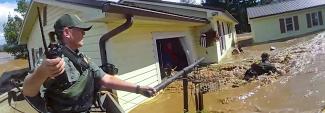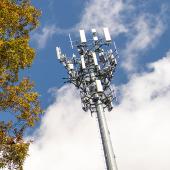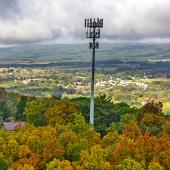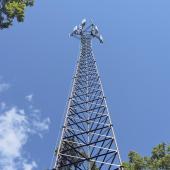In emergencies, communication is more than just a convenience — it’s a lifeline. When disaster strikes in remote regions or terrestrial communication networks fail, gaps in coverage can delay critical emergency response.
That’s where FirstNet deployables come in. Powered by the nationwide public safety broadband network, FirstNet deployable assets provide first responders with portable coverage solutions designed to restore and enhance communication capabilities where they are needed.
Understanding deployables
Since the earliest days of FirstNet, first responders have emphasized the need for temporary coverage solutions that are readily available and can support planned and unplanned incidents. The First Responder Network Authority (FirstNet Authority) created the deployable program to bring these solutions to public safety.
Deployables are mobile network assets that create cellular coverage in areas where existing infrastructure has been damaged or cannot support communication needs. They also bring coverage to areas where cellular infrastructure does not exist.
FirstNet deployables link to FirstNet via satellite and provide Band 14 connectivity, giving public safety agencies access to FirstNet features and capabilities like priority and preemption.
Deployables do not depend on fixed infrastructure, allowing responders to request, receive, and connect to them quickly, even in challenging environments. The coverage area provided by deployables varies by the type of deployable, as well as the terrain where the deployable is set up.
Types of FirstNet deployables
FirstNet offers hundreds of deployables in its dedicated fleet. To support rapid response, the fleet is strategically located at sites nationwide to ensure they arrive at emergencies in a matter of hours. Their various form factors and mobility make them adaptable to a wide range of scenarios, such as tornadoes, hurricanes, chemical spills, and large planned events.
Larger form factors in the FirstNet deployable fleet include:
- Satellite Cell on Light Trucks (SatCOLTs) are truck-mounted mobile units that can provide coverage up to a three-mile radius. These larger form factors leverage satellite connectivity to provide cell service in areas where ground-based networks have been destroyed or are highly congested. This makes them ideal for large-scale disasters, such as wildfires, or major planned events like the Kentucky Derby.
- Flying Cell on Wings (COWs) are tethered drones that provide aerial coverage to extend network reach. These are valuable assets in mountainous or heavily forested areas where ground-based solutions may be ineffective.
- Response Communications Vehicles (RCVs) are large vehicles that provide connectivity up to one mile via Band 14 and Wi-Fi. They can also serve as command spaces for first responders with two interior workstations, bunks, a microwave, and a mini-fridge. These assets are useful during long-duration operations or large-scale emergency response efforts in rural areas.
The dedicated FirstNet deployable fleet also contains smaller form factors. These assets can also be owned and managed by public safety agencies — giving first responders immediate access to and control over on-demand coverage.
- Compact Rapid Deployables (CRDs) are portable solutions that can be transported on a trailer hitch and set up by a single person in a matter of minutes. Their smaller size means they can fit in most doorways and elevators and can be transported by road, air, or water. CRDs offer coverage up to one mile and support several backhaul options, including prioritized satellite service, an ethernet connection, or LTE connection. They also support multiple power options, including shore power, DC from vehicle, battery, and gasoline-powered generators. CRDs are an apt choice for agencies operating in rugged, remote terrain.
- miniCRDs create up to a half mile of coverage with enhanced throughput and processing speeds. Packed into two ruggedized cases, they can be transported like luggage and offer multiple backhaul options.
To date, large and small deployables have been used for a variety of natural disasters, emergencies, and events.
Requesting deployable support from FirstNet
FirstNet subscribers can request deployables 24/7 at no additional cost. The easiest way to request a deployable is through the online request tool in FirstNet Central, the secure and personalized portal for FirstNet subscribers. FirstNet subscribers can also contact FirstNet Customer Care (1-800-574-7000) to request a deployable asset.
When making the request, be sure to provide as many details as possible about your communication needs, the location, the incident conditions, and the terrain, as well as any considerations about accessing the site. The FirstNet Response Operations Group™ (ROG), AT&T’s dedicated team of former first responders, uses this information to determine the best option for your situation. The ROG team explores deployable solutions, as well as alternate solutions like generators, Cell Booster Pros, Cell-Fi Go Reds, and other technology designed to optimize the network.
For more tips for requesting a deployable, consult the FirstNet Authority’s Emergency Management Resource Guide.
A game-changer for emergency response
FirstNet deployable assets ensure that public safety agencies can operate without communication barriers, even in the most remote areas.
These assets have proven highly effective and useful to the first responder community. As a result, the FirstNet Authority, the federal agency that oversees FirstNet, has invested in expanding the deployable solutions available, ensuring responders have coverage when and where they need it.
Through the deployable program, FirstNet subscribers can trust that help is always within reach — no matter the challenge, no matter the location.
To learn more about the deployables program or how the FirstNet Authority can help your agency prepare for a future planned event, contact your public safety advisor.















